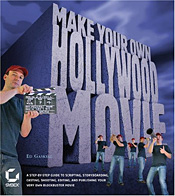Make Your Own Hollywood Movie
By Ed Gaskell
< Back

The advent of digital video and the decreasing costs of entry-level cameras and editing software have opened up filmmaking to a younger audience who were generally excluded unless they had rich parents or were incredibly resourceful. Given the explosion of interest in filmmaking in the teen market, it's slightly surprising that there aren't more books out there aimed at this growing audience. "Make Your Own Hollywood Movie," by Ed Gaskell, may be one of the first books directly aimed at the backyard filmmaker generation.
As you would suspect from the title, the book is targeted squarely at the genre end of the filmmaking spectrum, so if you're interested in backyard horror, action, or thrillers, then this book is for you. It cracks open the concept of low-budget DV filmmaking and lays out the process of getting your film from head to screen in a series of concise and accessible steps.
The book starts out with details about getting yourself set-up for digital filmmaking, covering cameras, computer hardware, and editing options. It's also very refreshing to see that the book is largely platform-agnostic when discussing post-production applications, providing a good discussion of the options for both PC and Mac users.
Sections 2 - 5 cover all the essentials of shooting (framing, lighting, sound etc), editing (principles, transitions, film language, colour correction etc) and mixing (volume, music etc) your film. Chapters are generally fairly bite-sized, but provide a good level of detail to get you thinking about the key issues you face at each stage. There's also a section on Distribution covering areas such as authoring your own DVDs and getting your film online.
But perhaps the most appealing aspect of this book is the final section, entitled "Hollywood Tricks." Gaskell provides guidance on achieving 22 techniques for a range of effects such as creating fake wounds, shooting car chases, creating ghosts, and simulating explosions. All of the techniques are safe and if executed correctly, provide surprisingly good results. We'd probably even dare to suggest that the principles of this section would appeal to a wider independent filmmaker audience than the remainder of the book.
"Make Your Own Hollywood Movie" probably isn't detailed enough for the older or more serious independent filmmaker, however if you are a high-schooler looking to get started in making your own DV movies, then this book should be totally up your alley. With its concise break down of the filmmaking process and accessible language, the book succeeds in providing a good deal of useful information in each major area, without being patronising or overly simplistic. The back-lot has definitely moved to the backyard.
< Back
